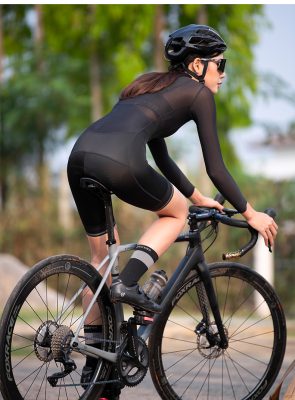Road cycling is a sport of endurance and aerodynamic suits can play a significant role in helping you ride faster. As an avid endurance and ultra distance cyclist, I was always curious to find out what is the optimum speed for an aero road cycling suit? In this article, we will reveal the facts about aero cycling suits. So you can understand the role they play and how they can help improve your speed while riding your bike. I wanted to cover this topic too because we see more and more professional teams going for one piece cycling suits even during classic races.
The days when these skinsuits were only used for time trials are clearly gone forever. This may well become a new trend in the pro peloton for much of the racing. And if the pros are doing it, then of course amateurs like you and me will soon follow.
It’s not a whole new category of clothing, but rather a special modification of an existing item. You may have heard of “compression gear” or even compression socks or compression stockings; this is a similar garment but instead of compressing your muscles and increasing circulation to the point of injury prevention, these cycling skinsuits specifically reduce aerodynamic drag instead.
Via this guide I will try to reveal all aero road cycling suit mysteries. I have based this on the most common questions surrounding this topic. By providing answers to these questions, all facets of the one piece racing skinsuit are addressed. If you have further questions about TT suits, feel free to let me know.
Are aero suits faster than classic aero cycling jerseys?
The answer depends on who you ask. The answer is also complicated by the fact that there are many different types of aero suits, and some are faster than others.
The most effective aero suits are made with “flat-back” technology. This means they have no seams or other features that disrupt airflow over the body. This type of suit was first introduced in 2004 by Giro and has since been adopted by other manufacturers. It’s also known as a skinsuit.
Flat-back suits use compression to reduce drag and improve aerodynamics, especially when traveling at high speeds or in crosswinds. An effective compression system will make it feel like you’re wearing nothing at all. But it is still providing enough support for performance and comfort during long rides.
While flat-back suits are the fastest option available today, they’re also the most expensive option available today. Especially if you want one that’s suitable for racing. You can expect to spend anywhere from $200-$500 on a quality flat-back suit from one of the top-rated brands but it’ll pay off in terms of speed over long distances
The reasons for wearing an aero suit are pretty simple: they’re much faster than regular clothing. Even than classic aero cycling jerseys. A recent study showed that wearing an aero suit reduces drag by up to 34% compared to normal clothing. That’s why you see them being used by top professionals such as Mark Cavendish and Bradley Wiggins at major races – they’re trying to save energy when they’re chasing down other riders and trying to break away themselves.

How much watt can you save by wearing an aero suit while cycling?
The answer to this question is that you can save a lot of watts. You will not only be faster and more comfortable, but you will also be able to ride longer and harder.
The exact amount depends on the type of aero suit you are wearing. Nevertheless, it is safe to say that if you are riding at a power output of 400-500 watts and you switch to an aero suit, your power output can be reduced by 20-30 watts. This will have a significant impact on your racing performance: by reducing your power output by 30 watts, you could improve your speed by 5-10 km/h (3-6 mph).
In addition to the increased speed, there are other advantages to wearing an aero suit while cycling:
- You will be more comfortable because you will have less drag (meaning less stress on your body)
- A lowe heart rate because there is less work required for your muscles
- You will breathe easier as there is less wind resistance against your chest
Which aero suit brand gives you the best bang for your buck?
If you want to get the most bang for your buck, an aero suit like the XXXXX will help you save at least 50 watts of effort over your normal riding kit. That’s a big difference, especially when you consider that each watt saved is about two seconds off your time. So if you normally ride in standard clothing and want to shave a few minutes off your time, consider investing in an aero suit.
What are other common names for an aero suit?
Aero suit is another name for a skinsuit. This is a tight-fitting garment worn by cyclists and other athletes to reduce air resistance and improve speed. The suits are made from lightweight materials that are breathable, but not mesh or mesh-like. Other names you often hear for the same piece of cycling clothing are skin suit, one piece road cycling suit, TT suit, speed suit and racing suit.

Are there any disadvantages of a wearing an aero road cycling suit?
The road cycling skinsuit is a form-fitting piece of clothing that provides the cyclist with an aerodynamic advantage when riding. The suit hugs the body, eliminating air resistance and increasing speed. Many cyclists will wear the suit during both training and racing. Although wearing a skinsuit for road cycling clearly has many benefits, the one piece suit also has some disadvantages, especially for amateurs who are not used wearing them:
- Comfort: They can be uncomfortable. Especially if you’re not used to wearing one or don’t have the right fit. These cyclists feel restricted in their skinsuit. This is especially true for new riders who are used to wearing baggy jerseys and shorts. Which is closely linked to the next disadvantage. The good news is that as you become more comfortable with your suit you’ll find yourself spending less time tugging on it and more time riding comfortably.
- Movement: They can restrict movement. Especially if your bike position isn’t set up properly.
- Body temperature: They can cause overheating. If you get too hot then it becomes difficult to concentrate on your riding. If you wear a skinsuit you might feel too hot in hot weather. This is because there aren’t any vents in the material. Besides the tight fit prevents air from circulating around your body.
- The looks: they can make you look silly on your bike; especially for the ones with a big belly. There are no bib shorts which can hide that belly a bit.
- The price: They can be expensive and may not be worth it if you only ride occasionally or don’t have time to train often enough to see results. A good skinsuit will cost you anywhere from $200 to $500. This is more than most cyclists are willing to spend on their clothing. Pro level ones, which are often custom made, will even cost you over $1K! If you want to improve and be faster than your friend…the costs are worth the suit!
What are the main benefits of wearing an aero suit?
The main benefit is that it reduces wind resistance. The faster you can go, the less effort you have to put in to maintain your speed. This means you will be able to cycle longer and harder before becoming fatigued. This is even more important in time trials where you are racing against the clock and not against other competitors. If you can maintain your speed for longer, then this will result in a faster overall time than if you didn’t wear one.
Improved aerodynamics . An aerodynamic suit will give you a significant advantage over other riders who do not wear one. It helps to reduce drag force and improve your cycling efficiency. This allows you to go faster with less effort, which is why many professional cyclists wear aero suits during racing events.
Closely linked to the previous benefits, the skinsuit will of course improve performance. A road cycling aero suit increases speed and reduces your effort to reach and maintain that speed. For example, if your average speed is 20 mph and you can improve this to 25 mph using an aerodynamic suit then this means that you have improved your performance by 25%.
Fatigue. If you need to spend less energy in maintaining a certain speed, fatigue will also reduce. You will be able to maintain a certain effort for a longer time. It also reduces the strain on your muscles and joints.
What are the alternatives for road cycling aero suits to reduce drag?
If you would still like to improve your performance by focusing on aerodynamics you could also consider the following items apart from a cycling skinsuit
- Arm/leg sleeves: These are in facts sleeves around each arm or leg that help to reduce drag.
- Aero socks
- Aero helmet
- Aero bike
Can you tell something more about the history of TT suits and one piece racing cycling suits?
The history of aero suits in cycling is a long one. The idea was first patented in 1978 by an inventor named Fred Lebow, who submitted his idea for an aero suit to the U.S. Patent Office.
The suit was marketed as a way to reduce wind drag on cyclists and make them faster. The idea didn’t catch on at first, but after some time, it eventually became popular among amateur cyclists.
In 1991, Lebow sold his patent rights to another company called Aerodyne Technologies Inc., which created a new design for the suit using polyurethane foam panels instead of cloth ones. This version of the suit became more popular among professional cyclists because it helped them conserve energy while riding at high speeds.
Pioneer and Tour the France Winner Greg LeMond
The first time the world saw an aerodynamic suit was at the 1984 Olympics in Los Angeles. American cyclist Greg LeMond was wearing one, and he won the gold medal in the individual time trial. eMond later went on to win the Tour de France three times, with his third victory coming after he was shot by an irate fan who didn’t like that LeMond had accused Lance Armstrong of doping. LeMond’s experience with the aero road cycling suit was very positive, as he managed to reduce his time by 1 minute and 30 seconds per kilometer compared with when he wasn’t wearing it. However, this experiment did not catch on among other cyclists for several years, since there were no suits available for sale at that time.

UCI Prohibition
Aero road cycling suits were banned in 1990 by the Union Cycliste Internationale (UCI), cycling’s international governing body, but cyclists continued to wear them anyway because they felt they helped them win races. The following year, the UCI announced plans to allow a limited number of specialized aero clothing for use in road racing competition only. It involved wind tunnel tests before approving them. Riders who tested positive for illegal equipment would be disqualified from races and fined $1,000 per infraction ($2,000 today).
The next time we saw an aerodynamic suit in a bike race was in 1994 at the Tour de France. This time it was worn by Dave Zabriskie, who would go on to win a stage and finish third overall that year.
In 2007, one company called Aerodynamics Incorporated (ADI) began manufacturing aero suits for cyclists and other athletes. This was followed by several other companies producing similar products. Since then there has been a steady increase in demand for these suits among professional cyclists and amateur riders alike. Aero suits have become more popular among pro cyclists and are now a regular sight at major races like Paris-Roubaix, the tour of Flanders and Milan-San Remo.
Are professional cycling teams using aero suits during normal races?
Yes, they are. Just take a look at some of the classic races like Omloop het Nieuwsblad, Kuurne-Brussel-Kuurne, the Tour of Flanders, Milan-San Remo and so on. You will notice more and more pro teams are switching to road racing skinsuits, even during non TT-races.

At what speed are aero suits in cycling really beneficial?
The benefits of aero suits in cycling are pretty obvious. They can significantly reduce drag, which saves energy and increases speed. But at what speed do they become useful?
The answer is surprising. It’s not until you’re traveling at about 25 mph (40 kph) or more that aero suits really start to pay off. That’s because aerodynamics become much more important as you go faster.
When you’re traveling at 15 mph (24 kph), the air flowing over your body accounts for only 10 percent of your total resistance. But by 30 mph (50 kph), it’s up to 70 percent. And climbing to 50 mph (80 kph) means that aerodynamics now account for 80 percent of your total resistance.
In other words, if you’re riding at 15 mph (24 kph), your aerodynamics are behind only two other factors: rolling resistance (coefficient of rolling friction) and gravitational force. Rolling resistance rises sharply as tire pressure drops; so it’s a bigger deal than aerodynamic drag at low speeds. Gravity also increases with speed until you reach high enough speeds where centrifugal force equals gravity and begins to overpower it.”
Do aero suits have a benefit at lower speeds?
A lot of cyclists have been experimenting with aerodynamic suits, helmets, and other gear for some time. For many years it’s been known that aero suits can provide a significant advantage at speeds above 25 mph (40 km/h). However, what is the benefit at lower speeds?
The answer is still up for debate, but there are some documented cases of riders being able to ride significantly faster on a flat road in an aero suit than they can without one. The most compelling evidence comes from an athletic performance test done by researchers at the University of Colorado in Boulder.
In this study, researchers tested three riders on two different bikes set up identically except that one was fitted with an aero helmet and one was not. The rider wearing the aero helmet rode at around 22 mph (35 km/h) with no wind resistance, while the rider without the helmet could only maintain about 18 mph (30 km/h).
Are there differences between a woman aero road cycling suit and a man aero cycling suit?
Yes, there is a difference in the fit of a woman’s cycling suit compared to a man’s. The main difference is that women generally have wider shoulders and hips. Women’s cycling apparel takes these aspects into account and therefore has extra room in the chest, stomach, and hip areas.

Is it beneficial to wear an aero road cycling suit if you are an amateur?
The answer is yes, but with a BUT 😊 You can get aero-shaped helmets, aero socks, sleeves and other aero improving accessories that will help you go faster on the open road. But you have to be willing to spend more money if you want an aero suit being an amateur. Besides the real benefit only starts at high speed. So if you’re not racing or training in high speed areas, you may be better off saving your money and going with a cheaper suit. We could say the real benefit only starts at high speed, above 20 mph or 32 km/h average. If you are reaching such speeds and you are doing time trial racing, fast group rides (more than 30mph), long distance events like centuries, brevets and gran fondos… go for it!
Aerodynamic suits are so effective that professional teams can save up to 2 minutes per stage of racing. So what does this mean for amateur riders? Well, it depends on how much time you’re willing to spend in an aero suit.

